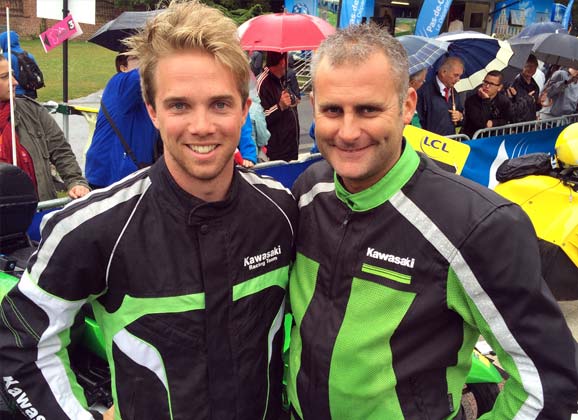On the day the Tour de France raced past the Australian War Memorial at Villers-Bretonneux this July, there was an extra Aussie rider in the peloton. RIDE‘s Jack Lynch got a taste of what it was like to be in the race – but he did so with a view from the back of a motorcycle. As we make our way through the off-season, here is his story of his experience in stage five.
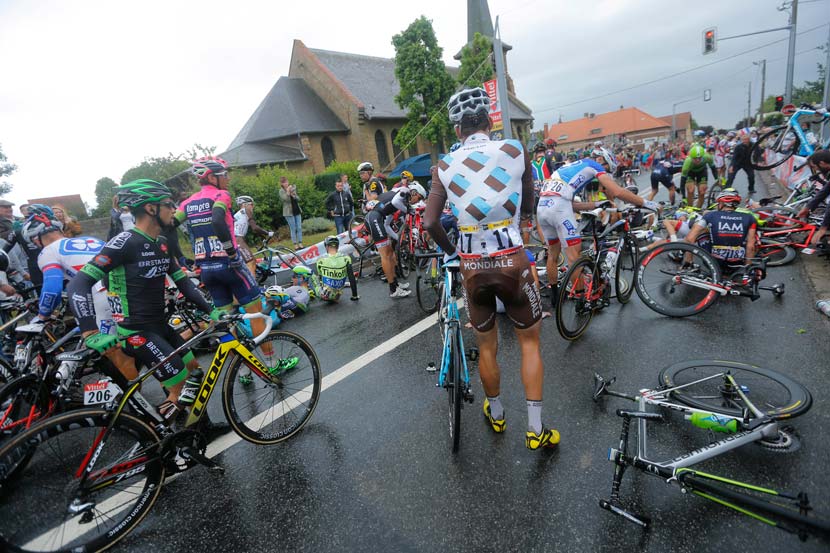
A new respect for the racers
– By Jack Lynch
It started slowly – nowhere near the pace I had anticipated. It was wet and windy so I suppose driver Seb, must have been taking it easy on me. When telling more experienced Tour de France correspondents of my upcoming experience on the back of a motorbike following the peloton, they gave a knowing smile.
“I hope you’re ready.”
This was common sentiment.
With this in mind, I expected instant terror. The anticipation of knee weakening moto-fear clouded my sartorial judgement and internal weather gauge. Both lapses of awareness could have escalated to a mood-slashing error.
I refused any jacket or extra waterproof layer despite the insistence of those around me. As the rain intensified, Seb pulled out a black and green Kawasaki jacket, I reluctantly accepted and conformed to the universally approved notion that riding on motorbikes means you get cold, fast.
When my pilot presented me with a waterproof coverall, I immediately recognised its importance. My stubbornness had resolved to common sense and I quickly slipped on this outer shield later realising that it was Seb’s own garment to keep him comfortably dry as he galloped his steel horse through the biggest race in the world. Later on, this realisation prompted a sense of guilt, especially as the morning drizzle developed into early afternoon showers and, eventually, heavy rain.
Guilt then gave way to gratitude and I don’t know how I would have coped without Seb’s generosity.
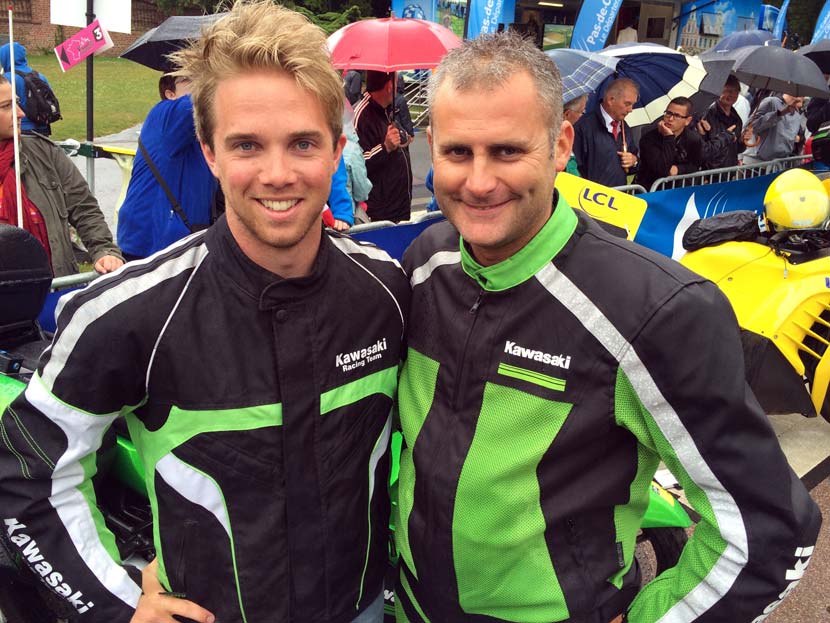
Jack and Seb, comrades for a day. Posing before the start of stage five.
The first few kilometres of my time on a motorbike – any motorbike – were pretty slow. We pushed off about 20 minutes before the start of stage five of the 102nd Tour de France, from Arras to Amiens. For the first 30km we rode in front of the race, cornering gingerly and never exceeding 60km/h.
Streets were lined with obsequious fans (just as they do on television) clapping and waving at us. It only struck me midway through the stage that the excitement spectators had for seeing their favourite riders racing in their streets created an admiration for the entire fleet of race officials.
The appreciation for Seb and his team was well received as the motorcyclists waved at the cycling-crazed masses and delivered updates from the race radio when they could.
Curiously, although the idea was that I would be embedded in the race, it took about an hour before I even saw a racing cyclist.
As we stopped for a quick sandwich (how very civil) we saw a solo breakaway racer ride past. Pierre-Luc Périchon held his forward gaze as three cars, eight motorbikes and a helicopter accompanied him on his quest for unlikely glory. A nasty headwind would keep him company for 189.5km if he were to succeed.
Seb then gave me the nod to finish my drink and get on the bike – we were going to follow this optimistic – and somewhat masochistic – bike racer.
What struck me was just how regular the man pushing the pedals was. When seeing the professionals on television they seem to be in rarefied air where nothing distracts or slows them as they average 45 for over five hours. Périchon was evidence that these pros are flesh and blood who ride on the same roads as recreational cyclists and suffer many of the same challenges.
I felt the sting in his legs as he swung left from a whipping crosswind and into a bullocking headwind. The rain was heavy now and as he crested a relatively small train overpass, I knew something of the fatigue in his legs and pang in his heart as his speed slowed to around 22km/h – a very human pace.
The professional’s ability to recover from this mental blow was impressive as he hastily picked it up again to 45 on the downward slope of the bridge. Pedals down, power up and the break goes on, nervously glancing at the fluctuating time gaps.
It was at this point where we pulled over and Seb said a sentence too long for me to grasp, except that a word resembling ‘peloton’ was caught.
“Oui,” was my insipid response.
We waited about four minutes at a T-intersection. There were two concreters, presumably father and son, having a rest from their day’s labour to watch riders flurry past. One was toting a cigarette, and the other – standing five metres away from his partner – looked intensely vacant as his eyes wandered everywhere but the road. Beside Seb and I was a policeman, standing without emotion, watchfully ensuring no vehicles interfered with the world’s greatest bike race.
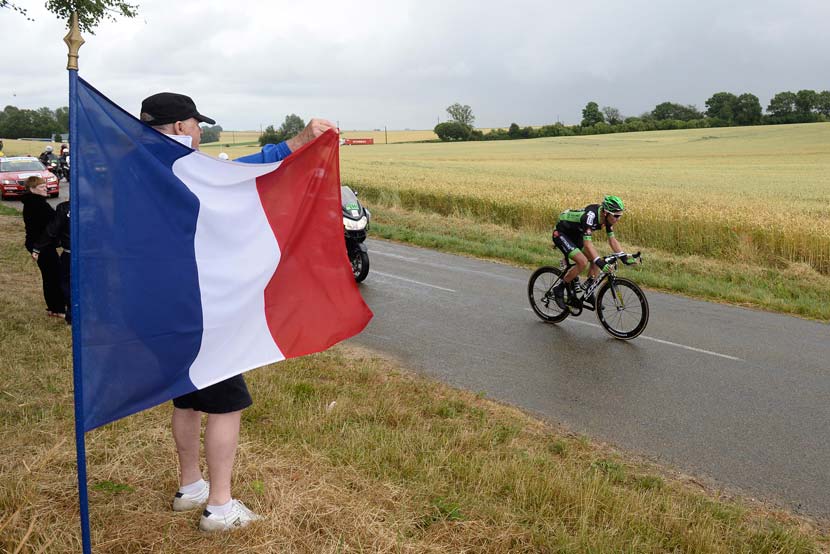
Pierre-Luc Périchon leads the stage… with Lynch’s moto right on his wheel (but hidden by the French flag).
Photo: Yuzuru Sunada
The buzz of the helicopter, police sirens, and hum of over 50 vehicles could be heard shortly before the placid peloton arrived. A group of 180-odd meandered along, spread across the road silently as each team planned its next move for a stage yet to add much to the narrative of a Tour which had already been full of action.
Such calm in the group presented a strange dichotomy for me – I was on the back of a motorbike at the Tour de France!
Such an experience would have transcended my wildest dreams register, so magnificent it seemed permanently out of reach. But my first glimpse of the peloton was so mainstream it seemed a little underwhelming.
I didn’t have too much time to mull over my unexpected dilemma as Seb fired up the Kawasaki and we rode off and into the peloton.
Any thoughts of monotony were quashed as my heart began to race. Seeing the professional cyclists’ faces up close when in their element was like nothing I’d ever experienced. Hundreds of hours watching bike riders through a screen away from the wind, rain and road grit is no comparison to viewing them up close.
We spent most of our time in the convoy of official vehicles sticking to the left of the road as the team cars jostled for position on the right with the riders squeezing their way between us with steely nerves.
The key protagonist for my early time in the bunch was the luckless Kiwi, Jack Bauer. Clearly injured, he was yo-yoing through the convoy for a couple of hours. pedalling squares with his left leg and producing no power with the right – he abandoned before the end of the stage. The diagnosis: a fractured femur!
The determination and pain on his open-mouthed and dirty face was distressing to watch and his withdrawal from the race was no surprise.
Seeing riders’ tenacity up close was a strange mix of inspiration and disgust toward the ‘beautiful sport’ and its characters.
What sort of event encourages such trauma?
Seeing Michael Matthews battle his way at the back of the bunch while racing with two broken ribs was painful and it gave me a renewed respect for Orica-GreenEdge’s bright, young talent.
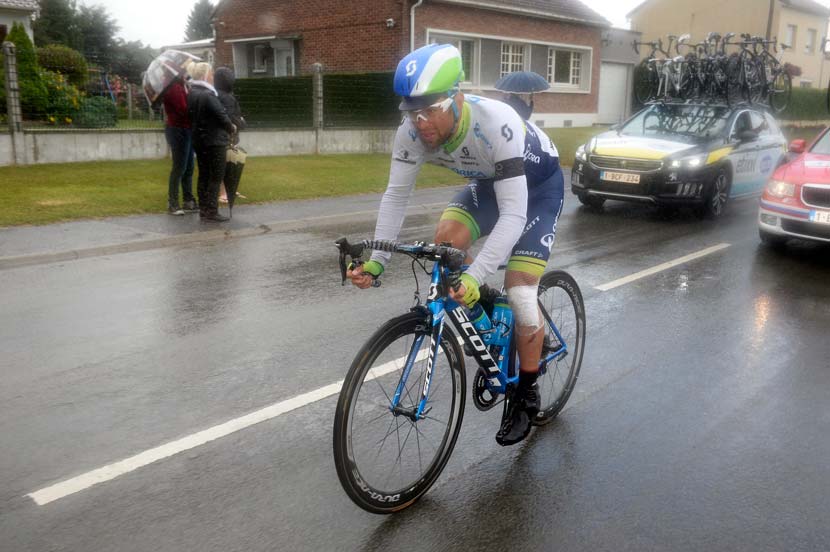
Michael Matthews struggles to hold the pace of the peloton.
Photo: Yuzuru Sunada
Matthews was awarded the ‘Combative’ prize for the stage.
The sponsor insisted a few years ago that the English translation change from ‘Most Aggressive Rider’ to ‘Fighting Spirit’ so that people understood what this reward is all about. Now, with my chance to see the effort Matthews put in just to finish despite his pain, I concur with the title. Fighting spirit was personified. Don’t belittle this with a passing reference to a red dossard and a brief appearance on the podium. They work for this and, for one of the many crash victims of stage three, it offered motivation for him to continue.
My first-hand observation of Matthews’ effort was only two days after the accident. The wounds were still fresh. His skin was still missing. His body was still wrapped up. And the bones near his chest were still broken. But he raced 189.5km in pouring rain… with no chance of success.
A little over a fortnight later, he’d make it to Paris. Tour debutant; Tour finisher.
Fighting spirit!
During stage five, my day on the moto with a close perspective of the peloton, I saw more than the TV cameras could ever capture. Seb impressed me. So too the luckless escapee, Périchon. So too Bauer and Matthews…
But it also reminded me that no one gets through this without the support of their team-mates. For Matthews, Luke Durbridge, Pieter Weening and Svein Tuft deserve plenty of additional praise; they helped their ravaged leader make it to the finish. I felt sure the 24-year-old would roll to the side of the road, unclip and call it quits in his first Tour de France. Until the 2015 Tour, Matthews had held the leader’s jersey at three Grand Tours (the Vuelta once, the Giro twice) but I’m guessing that he won more fans by surviving than he did when thriving.
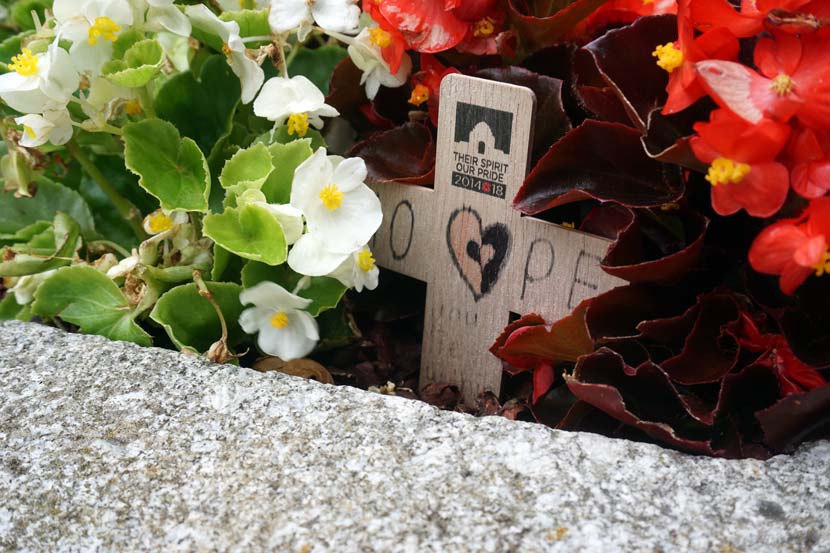
Lest we forget. There were reminders of WWI all along the route for stage five…
Lotto-Soudal rider Thomas de Gendt spent the final 100km of the race in the convoy battling the crosswinds and getting a drag from competitors’ vehicles. He was hitting 80km/h on farm roads just inches away from cars and motorbikes in all directions. He showed nerves of steel and phenomenal skill to make it through the stage. The Belgian also recovered from wounds as the Tour went on and ended up finishing ninth overall in the points classification.
A positive for de Gendt’s tough day in the convoy was that he avoided the spate of crashes which marred the fifth stage.
One fall with 25km to go completely decimated the peloton and gave me a first-hand view of the chaos that follow a chute.
Mechanics with spare bikes spare wheels rushed in all directions as riders picked themselves up from the tarmac. Some people were yelling and waving, while others stood around looking confused, not knowing whether to act or not.
Seb and I hung around for a minute or two before weaving the motorbike through the bodies and bikes searching for the lead bunch.
This gave him a chance to throttle up to about 160km/h as I ground my teeth and hung on with a white knuckled grip. I was nervous at these speeds, especially after witnessing another media Kawasaki misjudge a bend and wipe out into the roadside embankment. When we caught up to the bunch it we were the first moto in line sitting just next the commissaire’s car. This was as great a thrill as I had all day – especially at the speeds the race was humming along at.
With some riders dropping off against their volition it was heart-breaking – the rubberband lengthened until ‘snap’ and the only option was to soft pedal to the finish. Day over early, rest for tomorrow’s stage…
* * * * *
Tension was running high amongst the race’s official vehicles. One brash NBC motorbike was trying to interview some of the teams’ directeur sportifs in the closing kilometres. When the US broadcaster interfered with a Cannondale-Garmin rider, it received some clear instructions from an irate mechanic. The NBC bike filed quickly back into line where it would remain for the rest of the race.
With three kilometres to go, we dropped our pace back and it became clear I wouldn’t be anywhere near the finish. At the flamme rouge, we cruised past Michal Kwiatkowski who’d done his job; the world champion would role in away from the pointy end of the action. I’d then hear over the race radio that André Greipel had claimed his second stage win for the year.
A sprinter would win, but never believe the throwaway line: just another sprint stage…
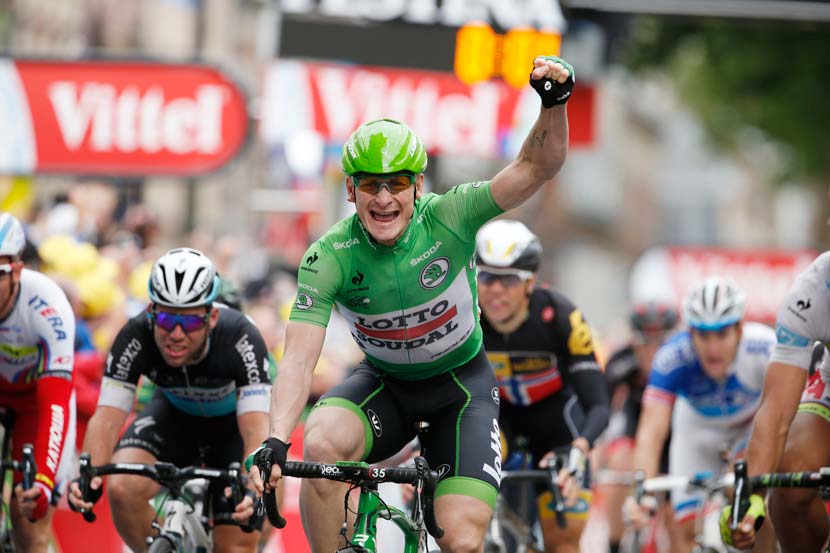
The second of four stage wins for André Greipel in Le Tour of 2015.
Photo: Yuzuru Sunada
As Seb and I crossed the finish line with aching legs and a sore bum after six hours on a motorbike, I knew it was my most memorable moment of my Tour de France debut. Greipel was shuffling his was through as sea of photographers to meet with his team-mates. When he saw his companions, he thrust away those ogling him from behind a lens and joyfully hugged his mates. The smile on his gleaming face was broad, brilliant and unforgettable.
There were dozens of hard luck stories and bruised bodies at the end of stage five, but seeing the one victor greet those directly responsible for his win was something amazing. Those who say cycling is not a team sport didn’t see the reaction from Lotto-Soudal after Andre’s giant win.
It was a bleak day in the saddle for the riders but an incredible one for me. The stage was particularly significant for Australia as it took place through the Somme battlefields – where the famous conflict was fought over four months during WWI.
From 1 July to 18 November in 1916, over one million soldiers from Allied and Axis forces were killed or wounded. Thinking about this whilst keeping up with the race was a sobering feeling. It was not easy to keep my mind off the effect this place had on so many soldiers and their families, especially because we scooted past too many burial grounds and war memorials. I even spied a few poppies starting to bloom.
It was surprisingly easy to imagine the war ripping through here in what was one of the bloodiest battles in history. No cyclist can compare his journey around the hexagon of France to WWI and no one was silly enough to suggest such a thing. There was recognition of what happened in this region of France. It was not a celebration. It was a tribute, a nod to that horrible piece of history. And the Tour entourage treated it with respect and understanding that you simply cannot get from other sporting contests.
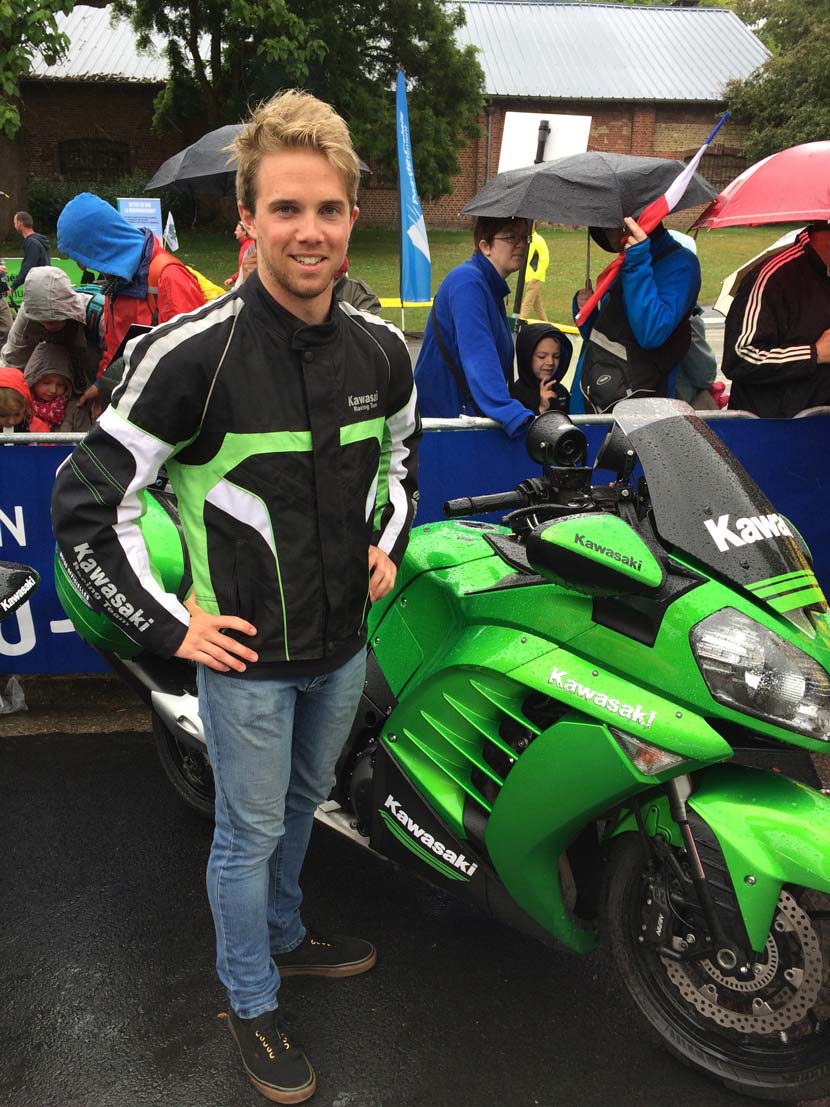
Tentatively confident… Lynch moments before he first sat on a motorbike.
I will never watch a bike race the same way again after riding on the back of a motorbike in the Tour de France. I have to pinch myself when reflecting on it. When in the race, the significance of it seems lost a little bit.
A stage starts, it ends, it gets discussed… and then tomorrow comes.
On returning to Australia, active participation in the race is a must. News and information is not compiled through osmosis but with late nights watching the race live on television and subsequently reading reports on what is happening in a bike race. The contest is as relevant as ever and the appreciation of hyped-up fans continues to spread to the all corners of the globe.
Perhaps one day I will feel entitled to some of the cheers and salutations of those lining the streets before the race, but until then I recognise that I am merely a cog in the Tour’s well-oiled machine… just another Australian writer wanting a cheap thrill amongst the rolling circus.
– Jack Lynch


